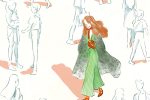Virgil Abloh grew up wanting to be an architect. A Rockford, Illinois, native, Virgil Abloh’s parents immigrated from Ghana and settled down in the Chicago suburbs, his mother working as a seamstress and his father managing a paint company. While his parents’ careers clearly laid the groundwork for his later ventures into the world of design, Virgil’s architectural aspirations were mainly cultivated by the potential to shape the world around him.
After earning his bachelor’s degree in civil engineering from the University of Madison-Wisconsin, Abloh moved on to The Illinois Institute of Technology where he received his master’s. It was there that he learned to combine the fields of art, craft and design, thanks to the curriculum of Ludwig Mies van der Rohe, one of the forefathers of modernist architecture.
Abloh is a Black man in America, a son of Ghanaian immigrants, a longtime DJ and close collaborator with today’s most influential artists, including Kanye West, A$AP Rocky and Travis Scott. These are all things that have not been historically associated with the creative director of a luxury fashion house such as Louis Vuitton.
And while Black culture, specifically hip-hop culture, has had long-term connections to the world of high fashion, brands such as Gucci and Dolce-Gabanna have made it abundantly clear that they want to remain white spaces. Not only have they refused to acknowledge the abundance of Black musicians that reference them in their music, but they’ve also even gone as far as to make explicitly racist clothing, such as the “blackface turtleneck” that appeared on the Gucci runway back in 2018. Hateful actions like these are discouraging, but Abloh’s breakthrough into the upper echelons of European luxury represents a step forward in the re-imagining of the high-fashion industry away from rich white elitism.
Abloh’s holistic understanding of design is integral to his creative process, regardless of the endeavor. Regarding architecture, he’s famously quoted saying, “I wanted to build skyscrapers because I figured if you could build the tallest building, you could design a spoon, you know?” In regards to the fashion world, he reflects, “There’s no line between a designer and consumer; I’m also a consumer.”
These quotes are just a small peek into the mind of one of the 21st century’s most influential creatives, and they are telling of how Abloh sees design. Most people are taught that the only way to succeed in life is to excel in one specific area, but Abloh prides himself on his ability to create across the borders of industry, designing an Off-White Jordan 5 one day and designing an actual basketball court at a Chicago youth center the next. Abloh’s melding of creative worlds is highlighted by his experience with different forms of design and the cultural capital he brings to the far-too-homogenous high-fashion industry.
After a successful rollout of Off-White Nikes, Abloh has continued his partnership with the brand, this time with one of the most respected names in high fashion: Louis Vuitton. By putting the LV monogram on an Air Force 1, Abloh is changing the narrative around the term “streetwear” from semi-derogatory to something that is interchangeable with high fashion.
In an Instagram post that gave a sneak peek of the upcoming Louis Vuitton Air Force 1, Abloh stated, “For the record, in my mind, therefore reality, these are Art Objects with a capital A, just as much as they are simply ‘shoes.'” The message here is clear; fashion as art cannot be defined by the Guccis and Pradas of this world; it’s as universal as life itself. The notion that it’s not has been derived from centuries of classism and racism.
https://www.instagram.com/p/CQjHYnwJQLU/?utm_medium=copy_link
Abloh questions this notion in a powerful way. A GQ article describes a note from Louis Vuitton’s latest collection: “By splicing together a suit and a tracksuit, he’s challenging the perceptions of what’s ‘formal’ and what’s ‘street’: ‘Is a man in tailoring trustworthy? Is a man in “streetwear” less trustworthy?’ … Is a sneaker ‘formal’ or is it ‘street’?”
Louis Vuitton’s Air Force 1 collab has been an homage to the hip-hop world since its inception. Abloh was inspired by Rob Base and DJ E-Z Rock’s album cover for “It Takes Two,” which features the 1988 hit single of the same name. The album cover presents E-Z Rock wearing customized Louis Vuitton Air Force 1’s as well as a Louis Vuitton tracksuit created by Harlem fashion legend Dapper Dan. As explained in the Louis Vuitton collection notes, “The cover embodied the hip hop community’s early practice of hacking together high fashion and sportswear, sidelining diverging brands with equal reverence. A cultural symbol in its own right, today the Nike Air Force 1 serves as an objet d’art emblematic of self-generated subcultural provenance.”
The note explains how the hip-hop community has been mixing and matching high fashion and streetwear for decades but until recently, the idea that a collab like this could occur at the highest level seemed unfathomable. As Brendan Dunne writes in his immersive piece on the collaboration in Complex Media, “Long before the sneakers became official, they were a vision, something purely aspirational. They were a proposal from Black fashion that a pair of basketball shoes could exist in dialogue with European couture.”
Unlike previous efforts by Abloh to create affordable high fashion, this collaboration is intended to elevate the Air Force 1 into the market of super luxury. Instead of giving streetwear a taste of high fashion, Abloh is taking the most common sneakers in America and demanding their respect in a world where “kick” is a four-letter word. While we are still nowhere near a high fashion industry devoid of ostentatious European elitism, Abloh acts as a beacon of hope for a future generation of creatives who aren’t accepted by the current world of luxury fashion. The creative polymath is yet to build his first skyscraper, but he’s laying the groundwork as the architect of something much more impressive: the future of high fashion.
















